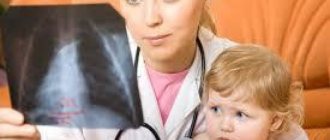Inflammation of the lungs (namely, it is denoted by the word “pneumonia”) is always associated among parents with a fairly serious illness of their child, causing understandable anxiety and bewilderment - how could this happen to the baby? How could this have been avoided?
Infants are special patients. Babies are most vulnerable to infections. And first of all, this concerns respiratory tract infections. It is at an early age that a high incidence of acute respiratory diseases occurs. The fact is that babies have some physiological characteristics that contribute to a greater risk of respiratory diseases. Thus, in infants, the nasal passages, lumens of the larynx, trachea and bronchi are quite narrow, and the mucous membrane lining the respiratory tract from the inside is prone to rapid swelling and swells easily. Removing mucus from the respiratory tract is not as effective as in older age. Babies' breathing, even normally, is not deep, shallow, so the possibility of aeration (air entering through the respiratory tract to the lungs and coming out again) is reduced. Lung tissue is more congested and less elastic than in adults. Thus, breathing difficulties in such children may occur more easily and their manifestations are more pronounced than in older patients.
Pneumonia in babies can occur independently, without a previous illness, but, as a rule, pneumonia in infants most often occurs against the background of an acute respiratory disease already suffered by the child, or pneumonia can be a complication of a specific infection such as influenza, measles or whooping cough.
Weak children are at particular risk for pneumonia. Frequent respiratory diseases, more serious pathologies that the child already has (for example, congenital pathologies of the lungs, heart), rickets, dystrophy (in which children are born with a deficiency of weight or do not gain enough weight) reduce the body's resistance. A factor such as hypothermia of the baby also contributes to the occurrence of acute respiratory disease (and therefore pneumonia).
Symptoms of pneumonia in infants
Since in most cases pneumonia occurs against the background of an acute respiratory disease, the child has difficulty breathing through the nose (the so-called “nasal congestion” is noted), and a high temperature occurs or continues to remain. Against the background of pneumonia, the baby’s temperature remains above 38°C. The baby’s breathing becomes frequent, “groaning,” and shortness of breath occurs. Parents themselves often note that the baby “has difficulty breathing.” If the child had a cough before, then, contrary to expectations, the cough may not disappear, but become “deeper” and more frequent. Sometimes vomiting occurs as a result. Regurgitation and unstable stool may occur. The baby appears pale, and there may be cyanosis (blue or gray color) of the nasolabial triangle (this is the area around the mouth and nose), which worsens with anxiety, coughing, and feeding. Due to deteriorating health, the child refuses to eat and often drink. No weight gain. The baby's sleep is restless, interrupted by coughing attacks. During periods of wakefulness, the baby is often capricious and cries.
It should be noted that the condition of infants with pneumonia can deteriorate very quickly.
Pneumonia in a child and antibiotics
In the last article “Fever, cough... child”, I began to talk about my former patients who moved to Holland. A nine-month-old baby developed pneumonia, which Dutch colleagues at first refused to treat at all, and then they seemed to begin treating it, but with very strange methods. They categorically did not want to prescribe antibiotics for pneumonia. Now I will tell you how this amazing (for me) story ended.
At that moment I was already practically in a state of prostration. Everything that I knew, what I taught to students - future doctors, the way I treated my patients, was subject to the most severe internal audit. My sleep was completely disturbed, at night I lay in bed and looked at the ceiling, turning over possible options in my head over and over again.
Yes, I knew that there are viral pneumonias, which theoretically do not require antibiotics, although in Russia it is not customary to make such diagnoses. In the end, I am also not a supporter of prescribing antibiotics without indications. But in this situation... The child has a temperature of 39 for the second week, coughs terribly, eats nothing, hardly drinks!
I could not find a single reason not to prescribe antibacterial drugs.
Pediatrician's comment:
Indeed, viruses can cause up to 40% of cases of pneumonia in children. Since antibiotics do not act on the virus, their use in this case is not necessary. But an important condition for making a diagnosis of “viral pneumonia” is the absence of pronounced infiltrative changes (damage to a segment, lobe of the lung) on the radiograph. The temperature during viral pneumonia should not last more than 3-5 days, while the blood will show a normal or reduced level of leukocytes.
Sveta’s baby was in the hospital for the 4th day. It was the 11th day of illness. The high fever and cough persisted. The shortness of breath, however, decreased with constant oxygen therapy, the child turned somewhat pink, although he still ate practically nothing.
- How are you doing? — I demanded a detailed report from Svetlana every morning. - They are planning to discharge us! — my mother stunned me with yet another incredible news. “They say they don’t know what’s wrong with the child; let the family doctor continue to treat him.”
I was speechless with surprise. I tried to imagine what would happen if the pediatrician of our hospital discharged a febrile infant home, untreated and underexamined. Probably, Rospotrebnadzor, the prosecutor's office, a dozen correspondents from federal newspapers and television channels would have arrived at the hospital in the morning, the entire management would have been fired, and the attending physician would have been deprived of his diploma in disgrace.
On the other hand, it’s true, what else was there to do in this strange Dutch hospital, where they treat with observation and an oxygen mask. On Sunday evening, Sveta and her son were already at home. At parting, the doctor left them the department’s phone number and said that “if the child stops breathing completely, call us and we’ll resuscitate them.” I couldn't believe my ears!
The circle is closed: the family doctor could not help, they went to the hospital with a fever and cough, with the same problems, and returned home, under the supervision of the same doctor.
“We need antibiotics!” — I repeated to Sveta like a mantra. In Europe, however, they are not sold without a prescription. Maybe we should buy a plane ticket to Russia, and here we can immediately treat the child? But it's expensive; Parents may also have problems with work: after all, they were released from the hospital, which means that the child, according to Dutch logic, can go to kindergarten, the temperature is not a hindrance...
Suddenly Svetlana remembered that she had taken some medicines with her from Russia “just in case”: “I bought everything according to the list of medicines for the south from your website!” On the horizon of my brain, inflamed by all this absurdity, a faint hope appeared. Svetlana sorted through the medications and read out the names to me. I listened intently. - Paracetamol, oxymetazoline, ambroxol, azithromycin, iodine... - What? Is there azithromycin? - it sounded like salvation.
Pediatrician's comment:
In a normal situation, I categorically do not recommend self-medicating and, at the first symptoms of a cold, swallowing antibiotics, which are often sold in Russia without a prescription. But in extreme situations, for example, on a hike or a trip abroad, it’s a good idea to have an antibiotic in stock, especially if you have a telephone connection with a doctor. You can arrange some kind of telemedicine session.
Sveta had only one package of the antibiotic azithromycin, with a volume of only 20 ml, which should have been enough for about 4 days. But, fortunately, after 5 days his worried grandmother from Russia was going to visit her grandson; she could bring more.
Until then, treating a bottle of medicine, which costs a couple of hundred rubles in Russia, as a priceless treasure, my mother dispensed it according to the instructions. Trying not to spill a single drop, the parents poured 5 ml into their son. And the child, despite the fact that the antibiotics were tasteless and bitter, obediently opened his mouth and swallowed the solution, as if he understood that in these 5 ml of tasteless liquid lay the key to his cure.
The next day the temperature returned to normal. After another 3 days, the cough decreased sharply. After about 10 days the child made a full recovery.
“This is what I think,” Svetlana told me later. “It can’t be that Dutch doctors are such scumbags.” Maybe, on the contrary, they are right, and we are just alarmists? And the child would still begin to get better the next day even without an antibiotic? What if it coincided that he felt better after taking azithromycin?
What was there to say? In medicine, theoretically, anything can happen. But I was absolutely calm. My picture of the world has completely recovered. For myself, I understood one thing. Maybe in Europe there are advanced kindergartens where you can go without a certificate, and calm doctors who won’t prescribe antibiotics in vain, but you need to think for yourself. If a child is clearly and seriously ill, although they persistently tell you that everything is fine, you can, just in case, seek advice from another specialist, even if only by telephone.
***
After I told this completely real story to my friends, the natural question was: why is infant mortality in Europe lower than in Russia, if they treat this way, or rather... don’t treat it? Firstly, I don’t know whether they treat only our compatriots this way or their own too. Secondly, given their positive attitude towards people with disabilities, they may not be afraid of the possibility of leading the patient to a serious complication and making the person disabled. And in terms of mortality, it’s most likely true that our European colleagues can very effectively and quickly provide resuscitation care and prevent death.
Mikhail Nikolsky
Photo depositphotos.com
Related products: (azithromycin)
What happens in a baby’s body during pneumonia?
The inflammatory process can affect a small area of the lung, in which case pneumonia is called focal.
If an entire lobe of the lung is involved in the inflammation, pneumonia is called lobar pneumonia, and the severity of the disease will usually be more significant. Inflammatory changes in the lung tissue lead to the fact that the lungs cannot perform their inherent function of gas exchange. Normally, a person’s lungs are responsible for the entry of oxygen into the body (more precisely, into the bloodstream) as part of the inhaled air and the removal of carbon dioxide. Violation of this process leads to the child suffering from oxygen deficiency, which is essential for all organs and tissues to function. The severity of the manifestations and, accordingly, the degree of the baby’s discomfort will depend on the area of the inflammation. But in some cases, it can be difficult to judge the extent of lung damage based on the manifestations of the disease.
In addition, the process of inflammation suggests the possibility of intoxication. Harmful waste products of bacteria and viruses poison the child’s body. Hence - weakness, headache, lack of appetite, causeless crying, etc.
The body reacts to inflammation and begins to fight. One of the means of control is an increase in body temperature (hyperthermia). Up to a certain limit, hyperthermia is protective in nature - viruses and bacteria begin to die. They consist of proteins that cannot withstand heat. But if the temperature stays at high levels for a long time, then this becomes harmful to the body, since in this case metabolic processes in organs and tissues, including the brain, change, and complications may arise - so-called febrile convulsions. In this regard, the high temperature must be reduced. The benefits of such hyperthermia will be less than the harm it can cause to the child.
How does pneumonia occur in infants?
Inflammation in the lung tissue can be caused by various types of pathogens. It could be bacteria, viruses. fungi and some other microorganisms. Why is it important to know the cause of the disease? the fact is that the suspected or precisely established cause of the disease allows the optimal treatment to be prescribed to the child. After all, there are drugs that kill bacteria and have absolutely no effect on viruses, and vice versa. And not all antimicrobial agents are equally good against a particular pathogen. In addition, depending on whether a viral or bacterial process develops in the lungs, the course of the disease can be predicted to some extent.
It should be noted that viral-bacterial associations do occur more often; a viral disease can serve as a trigger for the development of microbial (bacterial) inflammation.
Unfortunately, the ability to accurately diagnose the causative factor is quite limited. Thus, neither the clinical picture of the disease in a child, nor an X-ray of the lungs may answer the question of what caused pneumonia.
It is important! It must be remembered that everything that sounds incomprehensible to parents in the definition of a disease or in treatment tactics must be explained by a doctor. Don't be afraid to ask! Parents' knowledge of everything that is happening to their child contributes to a faster recovery of the baby.
Considering that establishing the nature of pneumonia (bacterial or viral) in clinical practice is extremely difficult (the true pathogen is almost never known), and also taking into account the frequent addition of a bacterial infection to the initial viral nature of the disease, the need for the earliest possible prescription of antibacterial therapy becomes justified infants.
Antibiotics do not act on viruses - they are active only against bacterial infections, but for those reasons. which have already been discussed above, early prescription of antibiotics for suspected pneumonia in children is the standard of modern treatment for this disease.
Pneumonia in newborns: causes and consequences
Newborn babies are at risk for this diagnosis. There are several reasons for this. First, it must be said that doctors divide this disease into several types due to its occurrence:
- Hospital - occurs in a hospital setting (usually secondary infection) during the treatment of bacterial or viral diseases. This type of pneumonia is very difficult, resistant to antibiotics and requires long-term hospital treatment and medical supervision.
- Community-acquired – infection occurs at home, on the street, in a public place, or in transport. The cause of this disease is most often viruses, and the infection enters the body through airborne droplets. As a rule, with timely treatment, this type of disease does not have serious complications.
- Aspiration - the disease is caused by foreign bodies (for example, small objects, food particles, breast milk, vomit during regurgitation) that enter the respiratory tract. Most often, newborns or infants are susceptible to this type of illness, due to the underdevelopment of the digestive and respiratory systems.
- Congenital – the most severe disease occurs in premature newborns. The disease develops against the background of an intrauterine infection with an immature or not yet formed respiratory system. Congenital pneumonia caused by herpes simplex viruses, cytomegaloviruses, mycoplasmas, and fungi appear in a child 7-14 days after birth.
So, the cause of pneumonia in a newborn can be both viruses and bacteria, and foreign objects that have entered the respiratory tract. What could be the consequences? We must remember that in newborn children all inflammatory processes occur very quickly and are systemic in nature: when the whole body suffers, the temperature rises to high levels, intoxication occurs, loss of consciousness, etc. And if it is not diagnosed in time and treatment is not started, then the baby may develop first respiratory and then heart failure, and he may die from fulminant pulmonary edema.
What is needed to confirm the diagnosis?
Since infants with suspected pneumonia should receive treatment in a hospital, the examination will be carried out in a hospital setting. Babies, as a rule, are hospitalized with their mothers, or the mother has the opportunity to stay in the clinic during the day, leaving the baby only at night. Even if before hospitalization the child was prescribed a blood test and it was done in the clinic, then in the future the same test will be repeated in the hospital. In addition, the baby needs to have an x-ray of the lungs. In a hospital, as a rule, they are not limited to this minimum. It is necessary to know how other organs and systems function. Therefore, the baby’s blood is taken from a vein and a urine test is performed, and if indicated, an additional examination is performed (for example, electrocardiography - ECG).
Features of nutrition of a sick child
A sick child's appetite is usually reduced, so it is necessary to feed him the food he likes. Food should be given in small portions. It is important not to force feed the baby. This can cause the baby to vomit and have a persistent negative reaction to feeding.
Infants with suspected pneumonia should receive hospital treatment.
If the baby is breastfed or mixed fed, it is important that the baby continues to receive breast milk. In this case, it will receive protective proteins produced by the mother - antibodies. These can be either antibodies to the pathogen that caused the disease in the baby, if the mother has previously encountered this pathogen, or nonspecific antibodies that help the baby cope with the infection in general. In addition, often when there is a decrease or lack of appetite, the infant refuses other food. Accustomed to suckling, he is content only with mother's milk. Often in his mother's arms he calms down and stops being capricious.
In pediatrics, there is a rule according to which a child should not be introduced to new types of complementary foods during illness. The child should receive food that is familiar to him.
For what reasons can pneumonia appear in children under one year of age?
It is not uncommon for a child to develop pneumonia in the first days of his life. As it turns out, infection of the fetus can occur even before its birth; in this case, doctors diagnose the intrauterine type of infection; it is most often characteristic of babies 1-2 months old.
The reasons for the development of pneumonia before birth are as follows:
viral infections suffered by the mother during pregnancy;- ingress of microbes: staphylococcal and streptococcal;
- fungal diseases of the mother that were not treated during pregnancy and the child, moving along the birth canal, manages to become infected with them.
That is why it is very important for every woman to monitor her health, attend antenatal clinics on time and take all the required tests. Since the appearance of any disease in the mother can have a detrimental effect on the health of the unborn baby.
And besides this, a provocateur for the development of pneumonia in a newborn can be the mother’s failure to comply with the basic rules of hygiene when artificially feeding the baby (if you do not boil the bottles before each meal and reuse the prepared formula solution).
And so, pneumonia in young children can be of several types due to the nature of the disease, namely:
Acute, the duration of treatment and ridding the child of residual effects is within two calendar months;- Protracted, in this case the baby has to fight the disease from two to eight months;
- Chronic, the duration of recovery from the disease is over 8 months, but a newborn rarely copes with this pathological process.
It should be remembered that the manifestation of the disease in the first stages of a baby’s life may be associated with the following factors:
- babies who were diagnosed with fetal hypoxia (oxygen starvation) after birth;
- in cases of development of asphyxia in a child during delivery or receipt of birth injuries;
- with an existing weakened immune system;
- if the baby has a heart defect;
- when a child is born prematurely (in this case, the respiratory system is not able to work at full capacity due to the fact that it is not fully formed);
- in cases where the baby acquires a chronic form of respiratory tract disease.
Pneumonia in infants, regardless of the cause that provoked the development of this pathology, should be treated only in a hospital setting.
This is due to the fact that the inflammatory process in babies develops very quickly and sometimes 2-4 hours are enough for bronchitis to turn into pneumonia. Hospitalization for pneumonia can occur in two ways - this is either a 24-hour stay of the mother with her child, or a daytime stay; when choosing the latter option, the parent must leave the hospital at the agreed time, and the baby, in any case, remains under the supervision of specialists.
Treatment of pneumonia in infants
The mainstay of treatment for pneumonia in infants is the early administration of an antibiotic. In children during the first six months of life, it is impossible to take antibiotics by mouth, so the baby is given injections. The choice of antibiotic is made by the doctor.
In the hospital, the baby may be prescribed oxygen inhalations. In addition, to better cleanse the respiratory tract, inhalations with the addition of herbs or special medications are used.
If the baby’s condition requires it (any complications have developed - for example, convulsions, symptoms of intoxication are extremely pronounced - a prolonged high temperature, the baby refuses food given to him by mouth, etc.), then the child is prescribed intravenous fluid administration (dropper ). Along with glucose and saline solution, the child can receive other substances necessary for him.
Antipyretics and expectorants are prescribed according to indications. Herbal decoctions that have the property of thinning phlegm are often used.
The serious condition of the baby may require the introduction of a special protein that has a protective effect - immunoglobulin. These are ready-made antibodies that can fight the pathogen.
Advertising
Congenital pneumonia
Due to a number of circumstances (acute and chronic infectious and non-infectious diseases, insufficient obturator function of the mother’s cervix, a long anhydrous interval during childbirth, etc.), some children are born with inflammatory changes in the lungs. Sometimes they develop pneumonia soon after birth. Congenital infection is especially common in premature babies, since one of the main causes of premature birth is infection of the amniotic fluid and the fetus.
The disease is usually severe. Therefore, nursing of sick babies is carried out exclusively in neonatal pathology departments or intensive care units. Despite the fact that neonatal pneumonia is a serious disease, modern medical technologies make it possible to successfully combat this disease. Among them are massive antibacterial therapy, immunotherapy, helium-neon laser irradiation of the projection area of pneumonia foci, etc. After discharge from the hospital, the child must receive medications that normalize the intestinal flora (bifidumbacterin, primodophilus) and multivitamins. In this situation, breastfeeding is also a remedy.
If a child has suffered congenital pneumonia, this does not mean that pneumonia will inevitably haunt him throughout his life. However, the likelihood of frequent respiratory diseases in such children is higher.
To prevent congenital pneumonia, a woman must treat all chronic foci of infection before conception or already during pregnancy. A balanced diet and a healthy lifestyle for the expectant mother are also important.
Possible complications of pneumonia in infants
If treatment is started in a timely manner, pneumonia does not cause significant disturbances in the general condition of the child. who has not received adequate treatment, after the severity of the process subsides, a long period of asthenia may be observed. In this case, the baby remains lethargic, gets tired quickly, needs more time to rest, and his appetite may be reduced.
In weakened children or with a late start of antibacterial therapy, pneumonia can become protracted. In addition, there is a risk of a chronic process with periodic exacerbations. Nevertheless, with proper organization of treatment, the threat of acute pneumonia turning into chronic is practically absent.
In some cases, despite treatment (and without it, this is even more likely), inflammation spreads to healthy areas of the lung. Foci of inflammation can merge with each other, ultimately occupying a fairly large area. The anatomical features of the structure of the lungs in young children determine the risk of rapid development of edema of the pulmonary tissue and the formation of pulmonary failure.
In addition to the lung tissue itself, the pleura (the “lining” of the lungs) may be involved in the process; pleurisy develops, further complicating the child’s breathing and causing chest pain.
In especially severe cases, tissue destruction occurs at the site of the inflammatory area in the lungs - their destruction with the formation of cavities in the lungs.
Pneumonia in infants in the first days of life
There can be several reasons for the occurrence of pneumonia in children in the first days of life: complications of viral and bacterial infections, foreign bodies entering the respiratory tract, as well as an aggressive external environment where the child ends up after being discharged from the hospital. Most often, the disease manifests itself in the cold season, when the load on the child’s newly developing immune system increases. What external factors can trigger the development of pneumonia?
- hypothermia of the body;
- chronic nasopharyngeal infections;
- dystrophy or rickets;
- avitaminosis;
- general exhaustion of the body;
- congenital diseases of the nervous system;
- anomalies and malformations
Therefore, after discharge, it is recommended to limit some of the child’s time with other people. Fathers, grandmothers, grandfathers, coming into the room from the street, before starting to communicate with the child, should take precautions: wash their hands, put on a protective mask, ideally change street clothes to home clothes. And, of course, if one of the adults suspects that they have some kind of viral disease, then under no circumstances should they communicate with the child.










